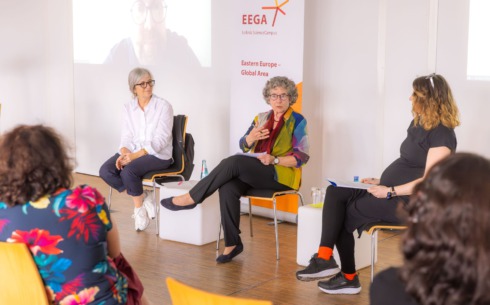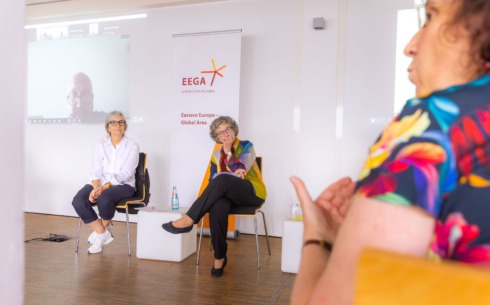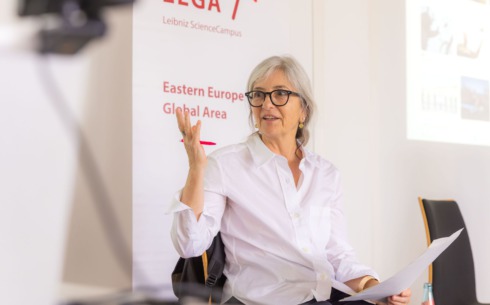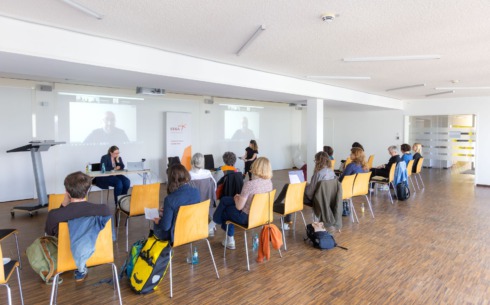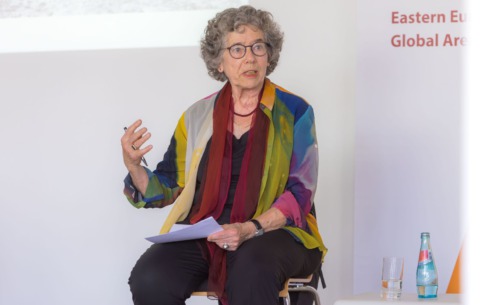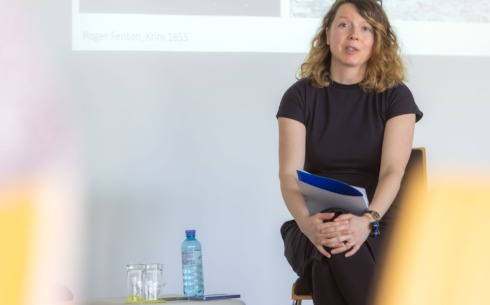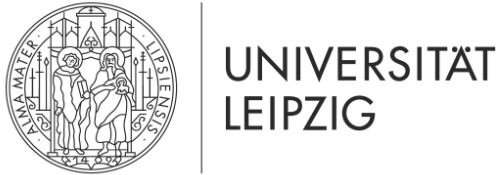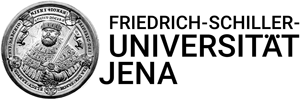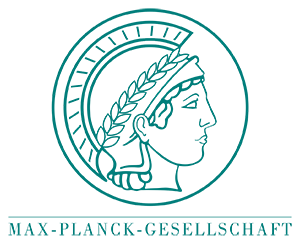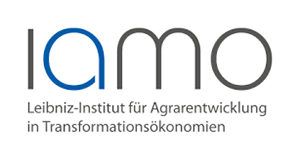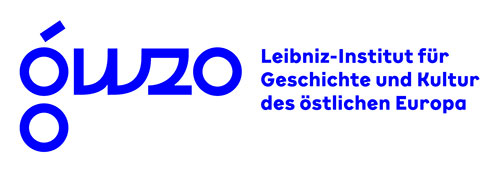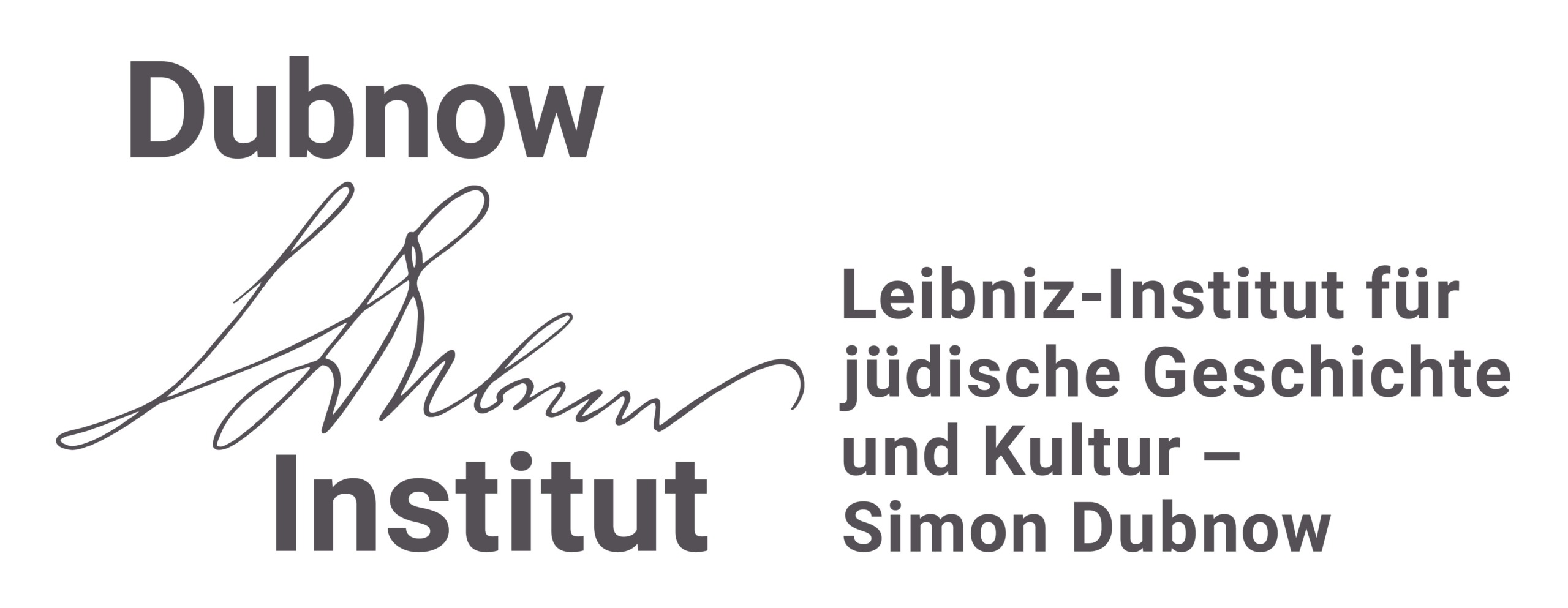Science Lounge in cooperation with KonKoop “Visualising War: Shifts in proximity, technology and care”
On 6 June, 2024, the EEGA Science Lounge, in cooperation with the project KonKoop (Cooperation and conflict in Eastern Europe), hosted a compelling event titled “Visualising War: Shifts in proximity, technology, and care.” The discussion featured esteemed guests: Prof. Monica Rüthers from the University of Hamburg, Dr. Bohdan Shumylovych from the Centre for Urban History in Lviv, who joined online from Ukraine, and Dr. Petra Bopp, an art historian and curator from Hamburg. Moderated by Mela Žuljević of the Leibniz Institute for Regional Geography, the event delved into the evolving visual narratives of war, exploring the implications of technological advancements and changing societal proximities and care structures in the context of conflict. The full-scale Russian invasion of Ukraine is one of the most visually documented conflicts in the history of war globally. Different actors and parties produce, publish and appropriate various kinds of images and visual representations on daily basis: social media photos and videos, crowdsourced maps of conflict sites, journalist reports, drone and satellite images, etc. The event started with short inputs of the invited guests, each focusing on different aspects of the topic.
Bohdan Shumylovych gave an insight into his seminars with university students in Ukraine and put an emphasis on the importance of visual arts and artistic outlet during traumatic experiences in war time, serving as a mechanism for processing and integrating difficult experiences and providing individuals with means of managing and making sense of their emotions and fears. Shumylovych gave the chance to get a glimpse on written statements and drawings by his students revolving around their nocturnal dreams, which were very impressive and scarred by “quiet trauma”. A term, that is used by Tanya Marie Luhrmann, Ann Kaplan and Chari Larsson, who often refer to it as ordinary trauma or “common trauma” (Deirdre Barrett). It encompasses the psychological effects of chronic stress, constant fear and ongoing adversity that people face during conflict. Dreams are a unique window into trauma and its consequences. (Deirdre Barrett, ed., Trauma and Dreams (Cambridge, MA: Harvard University Press, 2001). He closed his input with the quote by Viet Thanh Nguyen: „Alle Kriege werden zweimal geführt, das erste Mal auf dem Schlachtfeld, das zweite Mal in der Erinnerung.“.
Monica Rüthers delved into the past of using imagery and photography to discuss the historical development of motifs in war images in photography. Since the Crimean War, in which telegraphs were first used to transmit news in real time, towards contemporary image-making, a canon of motifs often emerged, where some wars have their own visual language, while others do not. Rüthers talked about the phenomenon of iconic images, perspectives of visibility and dealing with shock images. In doing so, she reflected on the use of technology and new media, such as the increased production of drone images by Ukrainian army and civilians in proactively documenting the war.
Petra Bopp gave the final talk providing a curatorial perspective to dealing with images of war. In particular, she referred to her work with images produced by soldiers and how their private collections work as selective memory of the war. She gave examples of dealing with such images in artistic and curatorial practices across different periods. In particular, she pointed out innovative curatorial approaches which focus on how visual material can be cared as an act of future-making.
With this event, the following four topics and questions were discussed:
1) Visual analysis: What is the role of visual material in documenting the war, as well as in influencing its public perception and political decision-making? How do visual analysis and visual history help us understand this? What does it mean to do visual history of war and how do we make sense of it as it is being made? What concepts, methods, approaches are relevant?
2) Science and Accountability: In addition, how can scientific approaches support public history and accountability? What responsibilities do scientists have in public discussions and uses of visual documentation, especially as evidence and testimonies in media, legal and archival contexts? What does the historical perspective reveal about the changing relevance of visualisations and visual expertise in the context of crimes against humanity and post-truth politics?
3) Intersections of the private and public: How have the relations of private and public ways of seeing transformed over time and reflected in the use of visual media? What effects do bottom-up participation and direct experience in image production have for the meaning and symbolic appropriations of visual representations? What kinds of images are produced through private archives and mediation of real-time, direct or mental experience of war? How do they challenge official narratives and what are their epistemological and cultural legacies?
4) Ethics and Emotions: What ethical concerns arise in collecting, analysing and publishing sensitive visual documentation? How do we, as researchers, deal with shocking images and the issue of desensitisation in an ethical and responsible way? How have curatorial and archival practices, as well as strategies of visibility and augmentation, evolved to address this?
Some impressions:
